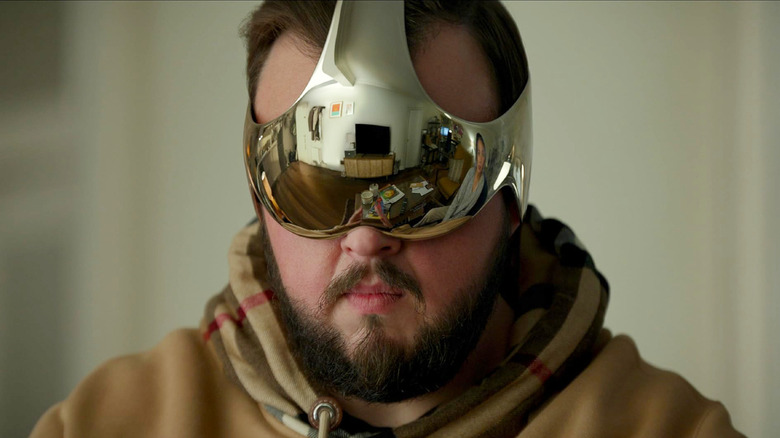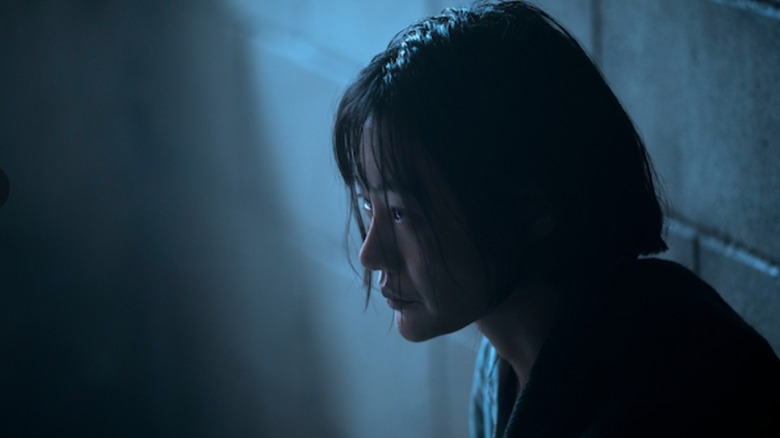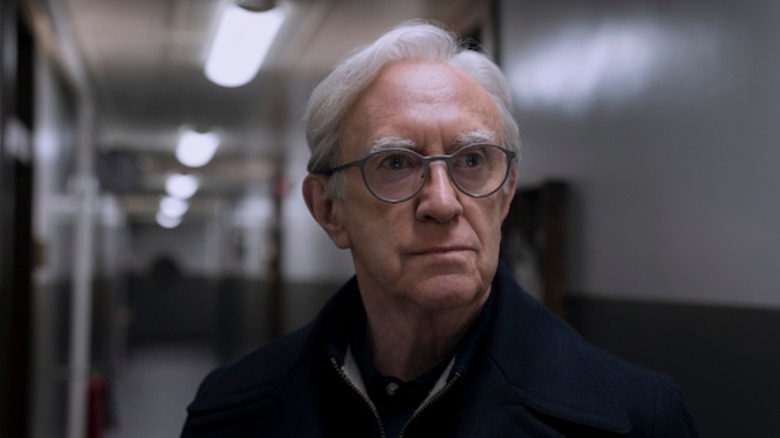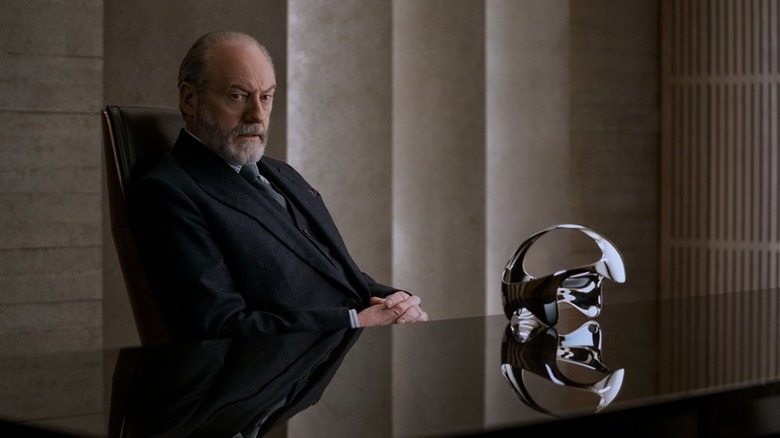3 Body Problem Season 1 Ending Explained: The Dark Forest Awaits
This post contains spoilers for Netflix's "3 Body Problem."
"You are bugs," declare the San-Ti, extraterrestrial beings from the Alpha Centauri system who are on their way to invade Earth within four light years. This is an audacious declaration of war, a reminder of an imminent invasion, plastered on every communication device on our planet, from public billboards to any device that supports a screen. This grim development occurs halfway through Netflix's "3 Body Problem," where the San-Ti create an illusion to reflect the Earth's surface on the sky, adorned by an all-seeing eye where clouds should be. The message is clear: They're watching our every move. And no matter what we might do to thwart this invasion, they're coming.
Created by David Benioff, D. B. Weiss, and Alexander Woo, Netflix's "3 Body Problem" is based on Liu Cixin's mind-boggling, brilliant "Remembrance of Earth's Past" trilogy, with season 1 mostly adapting the first book in the series, "The Three-Body Problem." Cixin's first novel in the trilogy captures humanity's reaction to the threat of invasion, including shades of stark existential horror, cynical indifference or denial, and devotional glee at the expected arrival of a superior species. Just like the first novel, season 1 of "3 Body Problem" ends with a silver living — a promising reminder that humanity's resilience can turn the odds in their favor, as dictated by years of evolutionary progress and survival:
"The Trisolarans [San-Ti] who deemed the humans bugs seemed to have forgotten one fact: The bugs have never been truly defeated."
Before we delve into what this means, and how this philosophy might shape the road ahead, let us dissect the threads woven within the context of what we already know about Cixin's world, which teems with the silent malevolence of a dark forest.
What to remember about the plot of 3 Body Problem so far
The year is 1977. After experiencing intense betrayal at the hands of humanity, a young Ye Wenjie (Zine Tseng) responds to a signal from outer space that explicitly warns her not to respond. The sender of the signal, a San-Ti pacifist, warns her that a response means that Earth's location will immediately be revealed, leaving them no choice but to advance in hopes of a new home planet. Already pushed to the brink by personal loss, Ye responds without hesitation: "Come. We cannot save yourselves." This single act goes on to alter the trajectory of life on Earth while revealing what it means to be human when exposed to the gaze of "the other."
In the present, Da Shi (Benedict Wong) is investigating the deaths of scientists by suicide, who have left evidence that they saw countdowns fused with their sense of reality. Among the deceased is Ye's daughter, Vera, who at some point mentored the Oxford Five — nanotech expert Auggie Salazar (Eiza González), theoretical physicist Jin Cheng (Jess Hong), physics researcher Saul Durand (Jovan Adepo), Oxford dropout/leader of snacks empire Jack Rooney (John Bradley), and physics teacher Will Downing (Alex Sharp). All five become entangled in the San-Ti scheme in one way or another, fulfilling their destinies to contribute to the cause of fighting back against the invasion. The biggest hurdle in this mission is that all the established physics in the last 60 years seems to make no sense — "science is broken," hampering their ability to develop next-gen technology to protect Earth.
The common link between the scientist deaths is the futuristic virtual reality headset gifted to them as a recruitment tactic, which mimics a simulation that underlines the titular Three-Body Problem. What does this mean?
What is the Three-Body Problem?
In the simplest terms, a three-body problem is a situation where the motion of three particles is chaotic and unpredictable as it is unsolvable according to the laws of motion and gravitation. Once Jin and Jack put on their VR sets, they are transported into a simulated world indistinguishable from reality, where the goal is to progress through the levels and determine why the people in this world keep dying. This world is supposed to be the San-Ti home planet, whose three suns have birthed Stable eras and Crisis eras — while Crisis eras can be predicted by various theories of physics, they cannot be controlled or evaded, as the planet is doomed to face a cataclysm due to its three-body problem.
The game is a recruitment tactic by the San-Ti, in collusion with Ye and environmentalist Mike Evans' (Jonathan Pryce) cult, who want the alien race to learn more about human culture and upend Earth's natural rhythm when they arrive. There is a genuine plea in Sophon's (Sea Shimooka) voice — the AI representative of the race — when she appeals to Jin about helping them survive, as the survival of one means the survival of all. The only solution to the three-body problem is to abandon the home planet and occupy Earth, and the approval of scientists like Jin or Jack means strength in numbers and least resistance when they reach our planet.
However, there are plans within plans, as the human organization kills Jack the moment he refuses to cooperate, underlining the fanatical devotion to the San-Ti that mirrors the impulses for ideological extremism rooted in our society. The San-Ti's cold insistence on thwarting Earth's scientific progress also points to deep-rooted fears and anxieties among species scattered across space, no matter how benevolent they might seem.
Why did the San-Ti abandon their human supporters?
By revealing Earth's location to the San-Ti, Ye had activated a metaphorical beacon in space, signaling the alien race to come and invade humans. Her explicit support for the cause soon helped amass a cult, partnered by Evans. His ship, "Judgement Day," housed members eager for their "Lord," whose arrival promised salvation and a new age for humans on Earth. With Auggie's nanotech invention, Judgement Day is sliced to bits with everyone on board, but the San-Ti do not intervene or protect them as promised. This sudden nonchalance is triggered during Sophon's final conversation with Evans, where the San-Ti learns something troubling about humanity: our ability to lie and deceive.
Although Evans' mission was to inform them about humans, this effort leads to the uncomfortable revelation of our inherent deceit, which the San-Ti struggle to comprehend. "We cannot co-exist with liars. We are afraid of you," they say, ceasing all communication and allowing the organization's "enemies" to intervene. The alien race also does not seem to have a grasp on literature or creative pursuits; they perceive these as "lies" and are confused by Evans' metaphor when he compares their common enemy to bugs. Ironically, this prompts the San-Ti to declare all humans as bugs, i.e. inferior beings who are a source of annoyance, to be squashed as they cannot be trusted or reasoned with.
Cixin's trilogy underlines a much darker truth, where the San-Ti quickly realize that humans are unaware of The Dark Forest, one of the most essential, terrifying truths about the universe (more on that later). In an attempt to correct their false assumption that we are aware of this truth, the San-Ti brandish their hostility, revealing their biggest ace: the eye in the sky.
How are the aliens able to spy on Earth?
Jin and Thomas Wade (Liam Cunningham) put on the VR headsets of the game and learn about San-Ti's plan, where they have found a way to "kill" our science to ensure their invasion is not challenged with leaps in scientific advancement (as is the norm with human breakthroughs in the field). A multi-dimensional proton was folded into a two-dimensional one to transform it into a sentient supercomputer — Sophon — who can survey Earth in real-time, disrupt science (hence the "broken" science), and manipulate sense-perception (which explains the blinking stars and the flash countdown the scientists see). This means access to memories and everyday conversations, allowing the aliens to keep track of counter-attack plans in real-time and robbing humans of agency or the element of surprise.
The first attempt by humans is to launch a human probe towards their fleet approaching one percent of the speed of light — not an impossibility, but a challenging experiment with a great margin for error — and the probe in question is the brain of a man doomed to die. Will, who is in the final stage of pancreatic cancer, becomes the willing candidate for the Staircase Program, where a chain of controlled nuclear detonations in space was meant to carve an accelerated trajectory for the human probe, but the probe veers off-course due to unforeseen factors. This is not only a scientific failure but a deeply personal one for Jin, who learns of Will's unconditional love for her when it is too late.
The second, more promising attempt is the Wallfacer Program, where three individuals are chosen by the United Nations on the assumption that the San-Ti cannot read our minds. The third Wallfacer is Saul, who rejects this responsibility. But can he?
What does the Wallfacer Program mean for humanity?
After suffering an attempt on his life, Saul is escorted to the fourth meeting of the Inter-Planetary Defense Council, where he is suddenly announced as a Wallfacer meant to formulate secret plans to save humanity in their minds without ever articulating this to anyone. As the San-Ti cannot read minds, this mission is meant to be foolproof, as anything the Wallfacers say in public will be perceived as lies, schemes, or diversions, including Saul's genuine attempts to reject the position. With unlimited resources at their disposal and a certain amount of power where their actions do not warrant questioning or justification, Wallfacers are the bastions of hope for a new era meant to shoulder this terrible purpose in silence.
The reason why Saul is chosen remains unknown, as the other candidates possess commendable qualifications compared to Saul, who is more of a cynic content with doing nothing for future generations (what with 400 years being a very long time). Even if he truly rejects it, humanity expects him to formulate a plan silently, and the dual attempts on his life prove that he is, for some reason, a threat to the aliens. The breadcrumbs to this secret lie in Saul's final conversation with Ye, who tries to plant the seeds of the Dark Forest theory in his mind via a convoluted joke metaphor. Although Saul has not registered this yet, he will inevitably be led to cosmic sociology and the Chain of Suspicion theory, which is the key to deterring the inevitable invasion of Earth.
Although the Netflix adaptation has taken liberties with characters, events, and basic narrative setups, the show will likely lean into a variation of the Dark Forest, and what it means for humanity in the future.
The Dark Forest will alter humanity's understanding of the universe
In Cixin's second book in the trilogy, "The Dark Forest," the concept is explained in vivid detail, but the essence boils down to this. According to this hypothesis, the Dark Forest is a direct answer to the Fermi Paradox — which underlines the lack of evidence of extraterrestrial life despite the overwhelming probability of its existence — where the universe is like a dark forest that inhabits alien civilizations, but they choose to remain silent and hostile. This silent hostility is due to fear that a more technologically advanced civilization will destroy them on detection, much like a hunter eliminating everything in its path, irrespective of the other's intentions. In this Dark Forest, detection is death, especially when targeted by a planet that cannot be detected or understood by the prey.
Ye's final words are, frankly, too cryptic to point Saul towards this hypothesis, but he will likely figure this out organically, allowing him to introduce terms of deterrence to the San-Ti. As we are not alone in the universe, a threat of mutual detection toward other hostile, more powerful civilizations can be a bargaining chip in the future, which also explains why the San-Ti are hell-bent on killing Saul. Once this metaphorical beacon is lit, there is no way to predict who might respond in what fashion, as the Chain of Suspicion dictates that even lesser civilizations can progress technologically within a short period, and benevolence can turn into wary malevolence at any point in time.
This brings us to the tender hope at the end of "3 Body Problem," where Da Shi tells Jin and Saul about the persistence of bugs on Earth, despite measures to exterminate them completely. Is this hope enough to sustain what comes next?
What does the ending of 3 Body Problem mean?
At one point, Sophon states that the lack of fear in a species leads to extinction, and that "humanity must learn to fear again." However, a counterpoint exists in Da Shi's hopeful statement that "the bugs have never been truly defeated" — they might or might not fear humanity, but it doesn't stop them from persisting, despite their lack of technological or cultural progress. Every home has a bottle of pesticide, meant to eradicate this species or reduce their numbers, but they have found a way to survive and co-exist despite being hunted.
The San-Ti might perceive us as bugs, and maybe we are bugs in the context of the grander scheme of things, but this does not have to be a source of hopelessness. It is important to fight in any way you can, and the Oxford Five have done their part or will keep doing it, irrespective of their failures. Auggie releases the formula of her nanotech invention to the public and is using it to help areas affected by drought, Saul has to fulfill the Wallfacer mandate and figure out a way to deter the invasion, while Jin will continue to use her scientific prowess to thwart the San-Ti. As for Will, his kindness and love for people already paints him as a hero who willingly contributed to a desperate effort that embodied scientific excellence. Similarly, Jack, gone too soon, was the first to question the San-Ti and their motivations — an essential act of bravery that helped expose their true intentions.
The fact that the San-Ti is not the worst that the universe has to offer is a cause for concern, as a dark, silent forest awaits, where every "armed hunter [stalks] through the trees like a ghost."
"3 Body Problem" season 1 is now streaming on Netflix.







